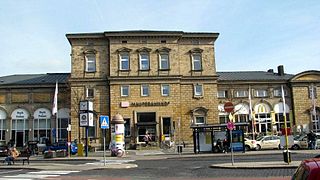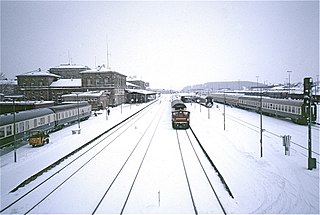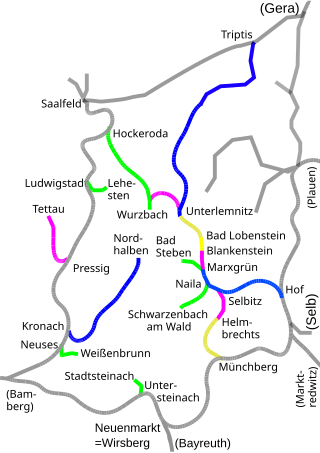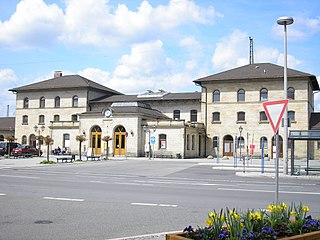
Upper Franconia is a Regierungsbezirk of the state of Bavaria, southern Germany. It forms part of the historically significant region of Franconia, the others being Middle Franconia and Lower Franconia, which are all now part of the German Federal State of Bayern (Bavaria).
Die Länderbahn GmbH (DLB), formerly Vogtlandbahn GmbH, is a German rail transport company based in Viechtach, operating transport services originally only in the Vogtland, but now also on a regional basis. Die Länderbahn is a subsidiary of Regentalbahn AG, which is owned by Ferrovie dello Stato subsidiary Netinera. The term vogtlandbahn remains in use as a trademark of Die Länderbahn in Vogtland.

The approximately 5,400 railway stations in Germany that are owned and operated by the Deutsche Bahn subsidiary DB Station&Service are divided into seven categories, denoting the service level available at the station.

Bayreuth Hauptbahnhof is the main railway station in the German town of Bayreuth, in northern Bavaria.

The DBAG Class 612 is a two car, tilting, diesel multiple unit operated by the Deutsche Bahn for fast regional rail services on unelectrified lines.

Hof Hauptbahnhof is the main railway station in Hof in southern Germany and is situated at the intersection of the Saxon-Franconian trunk line (Magistrale) and the Munich–Regensburg–Leipzig–Berlin line. When it was opened it formed the boundary between the former Bavarian Ludwig South-North Railway Lindau–Hof to the Saxon-Bavarian Railway on the Saxon side from Hof–Leipzig.

The DB Class 628 is a twin-car, diesel multiple unit operated by the Deutsche Bahn for local passenger rail services.

The Bamberg–Hof railway is a 127 kilometre-long main line that runs through Bavaria in southern Germany. The line runs from Bamberg via Lichtenfels, Kulmbach, Neuenmarkt-Wirsberg and Münchberg to Hof. The section from Hof to Neuenmarkt now forms part of the Saxon-Franconian trunk line.

The Hof–Bad Steben railway runs from Hof through the Franconian Forest to the Bavarian state spa town Bad Steben in southern Germany. The line was opened in two stages between 1887 and 1898.

The RegioSprinter is a German diesel railcar built by Siemens-Duewag for rapid regional railway services. Originally the RegioSprinter was designated as a Regional Combustion-engined Railbus by Duewag.

The Interregio-Express (IRE) is a local public transport railway service operated by the Deutsche Bahn which is only available in the German states of Baden-Württemberg, Bavaria, Saxony, Saxony-Anhalt and Berlin as well as in Switzerland. The IRE service was first introduced in the 2001 summer timetable, due to the increasing abolition of Interregio routes by DB's long-distance division. As a result, several German states ordered InterRegioExpress trains on the routes affected. In addition IRE trains were also introduced on routes that had not previously had an Interregio service.

The Schweinfurt–Meiningen railway, route number 5240, is a single-tracked main line in the states of Bavaria and Saxony in southern Germany. It is also called the Main-Rhön-Bahn and is listed in the Deutsche Bahn timetable as route (Kursbuchstrecke) 815. The railway has been part of the Erfurt–Schweinfurt route since 1993. Passenger services on the line are provided by DB Regio and the Erfurter Bahn (EB).

The Gemünden–Ebenhausen Railway is a 55 kilometre long, single-tracked, railway line in the northern part of the province of Lower Franconia in Bavaria, Germany. It runs from Gemünden (Main) via Bad Kissingen to Ebenhausen and follows, for most of the way, the Franconian Saale river.

The Weiden–Oberkotzau railway is a two-track main line railway in Bavaria, Germany. It connects with the Regensburg–Weiden railway in Weiden in der Oberpfalz and runs via Marktredwitz to Oberkotzau, where it joins the Bamberg–Hof railway. The line forms part of a long-distance route from Munich to Hof, continuing to Leipzig and Dresden.

The Bamberg–Rottendorf railway is a two-track electrified main line railway in the German state of Bavaria. It is about 100 kilometres long and was built by the Royal Bavarian State Railways as part of the Ludwig's Western Railway from Bamberg via Haßfurt and Schweinfurt to Würzburg. Between Bamberg and Schweinfurt, the line runs largely along the Main river. The line was opened in sections between 1852 and 1854 and is one of the oldest railways in Germany.

Saxon-Franconian trunk line is a modern term for a double-track railway route between the German cities of Dresden and Nuremberg. It is 390 kilometres long and currently electrified from Dresden to Hof. The concept of the Saxon-Franconian trunk route was developed in the transport policy debate in the 1990s during consideration of direct rail services connecting Dresden and Görlitz with Karlsruhe and Oberstdorf. The term is not traditionally used in relation to the railway lines now described by it.

The Nuremberg–Cheb railway is a 151 km long, non-electrified main line, mainly in the German state of Bavaria. It runs from Nuremberg via Lauf an der Pegnitz, Hersbruck, Pegnitz, Kirchenlaibach, Marktredwitz and Schirnding to Cheb in the Czech Republic. The route is also known as the RightPegnitz line (German: rechte Pegnitzstrecke or the Pegnitz Valley Railway. It was built as the Fichtel Range Railway. The Nuremberg–Schnabelwaid section of it is part of the Saxon-Franconian trunk line.

The Schnabelwaid–Bayreuth railway is an 18.2 km long single-track main line from Schnabelwaid via Creußen to Bayreuth in the German state of Bavaria. It is part of the Saxon-Franconian trunk line.

Lichtenfels station is in the town of Lichtenfels in Upper Franconia in the German state of Bavaria. It is a regional rail hub and a former ICE stop on the Hamburg–Berlin Munich route and is classified by Deutsche Bahn as a station of category 3.

The Westfrankenbahn is a RegioNetz of the Deutsche Bahn AG based in Aschaffenburg.



















